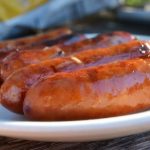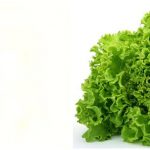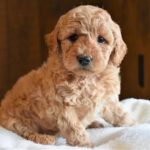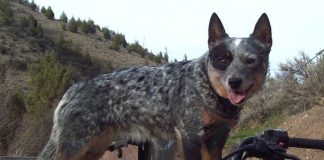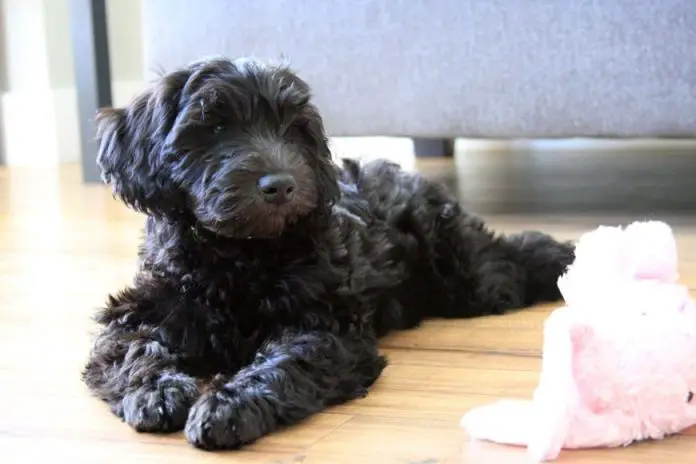
F1B Labradoodles are generally hypoallergenic because they are 25% Labrador and 75% Poodle. However, this doesn’t mean that they won’t shed at all. F1B Labradoodles with a curlier coat won’t shed because they have acquired more of the curly coat of its Poodle parent.
The F1 generation has a coarse wiry coat and sheds. Breeders aimed to “correct” this problem by breeding an F1 back to a Poodle. The puppies may inherit the curly or wavy coat of the Poodle and look like a Labradoodle.
F1B Labradoodles are usually a good option for those who have allergies because of their Poodle genes. The F1B has the intelligence and desire to please and learn, making them a popular breed among dog lovers.
Size
Labradoodles tend to be large dogs because the Standard Poodle and the Labrador Retriever are large breeds as well. F1B Labradoodles, however, are available in different sizes because this characteristic depends on the size of their parents.
Fully grown F1B Standard Labradoodles usually weigh around 50 lbs to 65 lbs. Females are 21″ to 23″ in height, while males are normally 22″ to 24″ tall. F1B Miniature Labradoodles weigh 25 to 45 pounds and should be about 14″ to 16″ in height. Medium Labradoodles weigh 30 lbs to 45 lbs. Females should be 17″ to 29″ in height, while males should be 17″ to 19″ high.
Personality
F1B Labradoodles are smart dogs that are very friendly, devoted and energetic. They can make a great family pet, provided that they are properly trained. F1B Labradoodles treat everyone like their friends. They are gentle and happy dogs that show their joy through enthusiastic playing and jumping.
This breed is usually laid-back thanks to its Labradoodle parent. However, not all dogs are the same. You might encounter a poorly bred F1B Labradoodle with a nasty temper. If you find a well-bred F1B Labradoodle with a nice temperament, you will definitely enjoy the perks of owning this breed.
There are various factors that can affect a dog’s personality. These factors include socialization, heredity and training. Dogs with a nice temperament are eager to approach people and play with them. Before you buy one, it’s best that you meet the puppy’s parents to make sure that it has a good temperament.
You can also meet the siblings of the pup to get an idea about what the puppy will be like when it grows up. Pick a puppy that is not hiding in one spot or bullying his littermates. F1B Labradoodles need early socialization. They should be exposed to different experiences, people, sounds and sights when they are still at puppy age. Early socialization will help them become well-rounded dogs when they grow up.
You can enroll your dog in a puppy kindergarten class or invite guests over on a regular basis. Taking your dog to busy parks and stores that allow pets can also help improve their social skills.
Feeding
Give your dog 1 to 2 and 1/2 cups of dry food every day. Divide this amount into 2 meals. This will also reduce his risk of bloating or gastric torsion. Any Labradoodle offspring can inherit this condition from their Labrador Retriever parent.
The amount that your dog will eat depends on his build, size, metabolism, activity level and age. Dogs have different requirements when it comes to food. If your dog is active, he will definitely eat more. You also need to make sure that your dog is eating high quality food.
Measure his food and feed him two times a day instead of leaving food out throughout the day. Give your dog the hands-on and eye test if you are not sure whether or not he is overweight. His waist should be noticeable when you look down at him.
His ribs should not be visible, but you must be able to feel them when you put your hands on his back and spread your fingers downward. If you cannot feel his ribs, it means that he is overweight and that he should exercise more and eat less.
Is the F1B Labradoodle Allergy-Friendly?
Not all Labradoodles are 100% hypoallergenic. Some of them are allergy-friendly, but others are not. If you want to know whether you or one of your family members has an allergy to pet dander and hair, you should try to be around one for at least a day or more. The fur of F1B Labradoodles is more consistent compared to the first generation.
Care and Training
This breed is not ideal for small apartments because they need to be exercised for at least 30 to 60 minutes every day. F1B Labradoodles would do well in a fenced yard where they can run around and expend their energy. This breed is a great jogging buddy. You should also give them some time off-leash, so they can burn off steam.
F1B Labradoodles are energetic and intelligent, so they need to be intellectually stimulated. If they become bored, they can become destructive. This breed is eager to please, so you should train them through positive reinforcement and consistency. They don’t require an overly firm hand, so they are a good choice for first-time dog owners.
Socialization should start from puppyhood because this breed tends to dive headfirst into situations without paying attention to the feelings of other canines. If the other dog is aggressive, your pooch might get in trouble.
One of the best things about F1B Labradoodles is that they can get used to living in rural settings and city or suburban environments. They are companion dogs that should stay inside the house. This breed is happiest when sleeping in a comfortable bed next to yours.
If you want to prevent accidents inside the house, you should start crate training your dog from puppyhood. They can also stay inside the crate if they want to take a nap.
Grooming
The desired length of coat for Labradoodles is 4″ to 6″. Regular grooming prevents matting and knots. You can take your pooch to a professional groomer if you want to give him a specific haircut. Some owners prefer to have their dog’s head trimmed and the entire body shaved twice a year to an inch.
Most people give their pet a body trim, bath and nail trim 4 to 5 times a year if they can prevent mats and knots from forming through regular grooming. Use a high quality dog conditioner and shampoo when giving your dog a bath. These products should be applied every 2 months to keep their coat clean.
Shedding
Some people believe that F1B Labradoodles won’t cause any allergies since backcrossing an F1 back to a Poodle is supposed to boost the possibility of the offspring not causing any allergies. As mentioned earlier, there’s no guarantee that the resulting mix will be hypoallergenic. If you want to know whether your Fido is hypoallergenic or not, you have to get his saliva and hair tested.
Poodle coats don’t have the dander that some individuals are allergic to. You have to keep in mind that there is no dog that doesn’t shed at all. Some dogs, however, shed more than others. Poodles have coats similar to human hair. Their coat grows and doesn’t fall out at once.
The hairs that fall out usually cord, so you can only remove them when you brush their coat. On the other hand, the fur of Labrador Retrievers grows to a specific length and falls out eventually. This happens throughout the year. As such, Labradoodles need more grooming than other breeds. Their coat needs to be clipped 2 to 6 times every year, depending on how fast their coat grows and what you want them to look like.
Doodle coats usually need semi-regular brushing to prevent matting. Long, wavy and curly haired dogs, in particular, can benefit from this practice. Shaving their coat will cause painful matting. F1B Labradoodles with a woolly coat need to be clipped once a month. This may require more time and money, so you may want to consider these factors when you’re thinking about getting a Labradoodle.
You can’t determine what the adult coat of your Fido will look like until he’s 18 to 24 months old. The coat color and type of Labradoodles change as they grow older. It changes a lot during their puppyhood and goes through 2 to 3 more stages before reaching its permanent type. During these changes, increased shedding will occur.
You have to consider various factors when buying an F1B Labradoodle. Different kinds of doodles have different dander and coat characteristics, so you have to be careful especially if you have allergies. It’s usually the dander that causes them.
Pros of Getting an F1B Labradoodle
Labradoodles will learn anything taught to them, as long as you put in the time and effort required for it. They are fairly active dogs, so they are great for those who love to exercise. F1B Labradoodles are also great with older kids because they are affectionate, mischievous and energetic. If you have a very small child, you should wait a bit because this breed is extremely playful when young. You can also consider a mini F1B Labradoodle.
F1B Labradoodles usually have the temperament, laid-back nature and intelligence of the Labradoodle. They can be a good option for those who are looking for a non-shedding dog because they are 75% Poodle. This means that they are less likely to shed. F1B Labradoodles might be good with other Fidos as well but they need to be supervised when they are around other pets such as cats.
F1B Labradoodles come in various colors such as apricot, black, caramel, red, chocolate and cream. You can also find them in parti colors. Labradoodles in parti colors have equal amounts of apricot and white, black and white or chocolate and white.
Cons
F1B Labradoodles are not ideal for those who are not at home all day. They like company because they are social dogs. If they don’t get enough stimulation, they become bored and destructive. They love to run around and get muddy. If you are fine with these requirements, an F1B Labradoodle is a good option for you and your family.
Health
Labradors and Poodles, the parent breeds of Labradoodles, are generally healthy. However, they are likely to suffer from several health issues and their offspring can inherit these problems. You have to look out for epilepsy, elbow and hip dysplasia, heart problems, eye problems, ear infections and patellar luxation.
The parents and puppy should undergo eye tests. You should also check the elbow and hip scores of both parent breeds to reduce the possibility of an offspring having elbow or hip dysplasia.










